
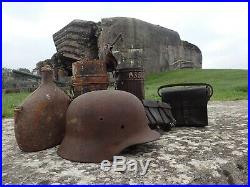
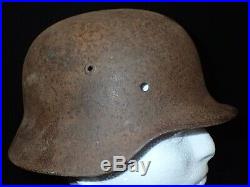
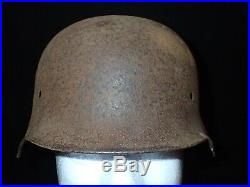
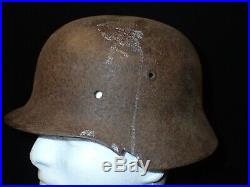
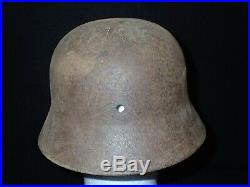
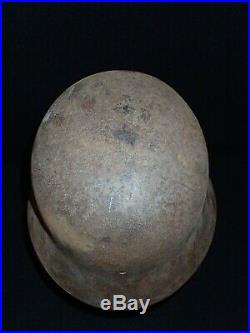

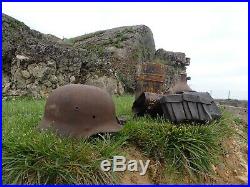
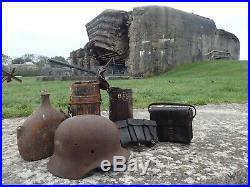
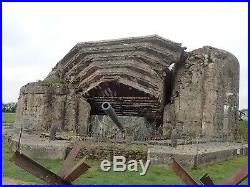
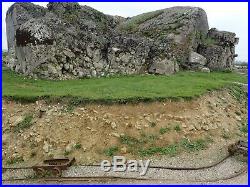
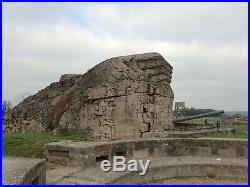

WWII German Kriegsmarine M40 Helmet Atlantic Wall D-Day Utah Beach Crisbecq Battery Pillbox R683 Skoda 210mm Coastal Gun – Garrison. Normandy, France – Artifact Recovered by Curatorial Staff of the Crisbecq Battery Museum on explorations of the Pillbox R683 in 2017. The curator of the museum granted us special permission to take the items from R683 out on the grounds and stage them for photographs with the coastal battery. This is a once in a lifetime opportunity to own a true Kriegsmarine helmet from the D-Day Landings June 6, 1944 recovered from a primary coastal defense battery which was firing on the landing fleet at Utah Beach and also subsequently the landings on Utah Beach. The mighty Skoda 210mm R683 Pillbox; having a maximum range of 33km, its dimensions are quite impressive 21m X 16m with a height of 8m some 2000 m3 of concrete and more than 100 tons of steel went into its construction. The collapse of the R683 was caused by an accident – when the Americans arrived at the battery it only contained prisoners and the war-wounded. During the night of the 11 and 12 June 1944 the German Garrison, due to dwindling troop numbers, had received orders to abandon the battery and fall back. The Americans therefore set out to destroy the munitions though accidentally blew up the munitions storage bay behind R683; approximately a dozen US Soldiers lost their lives in this accident. The back half of the pillbox had been sealed up since the end of the war and only in 2017 did staff manage to move enough debris to access the interior of the collapsed bunker complex through the roof; this helmet amongst other artifacts were recovered during the exploration of the bunker complex. The museum showcases numerous artifacts recovered during the 2017 effort. Exploration of the bunker complex is extremely hazardous and according to the staff they do not have further plans to enter the collapsed battery. Other items photographed were also acquired from the museum at the same time and will be offered for sale separately – two types of gas mask canisters {Atlantic Wall defenders were under constant concern of a chemical barrage accompanying any landing} an ersatz leather pouch & French military issue canteen; plus, a standard K98 leather ammunition pouch. Additional photographs show the current condition of Collapsed Bunker Pillbox R683. Interestingly the Atlantic Wall defenses were a hodgepodge of various caliber coastal & artillery guns captured during early war exploits. While the defensive positions and constructions were formidable the reliance on ersatz equipment, captured guns, and the necessity to store numerous calibers of shells rendered the Wall of little use for any sustained siege. The fate of the Crisbecq Battery and its history are testament to this fact (please read further for a comprehensive history). Was a German World War II artillery battery constructed by the Todt Organization near the French Village of Saint Marcouf. It formed a part of the German Atlantic Wall coastal fortifications. Including the battery commander. Walter Ohmsen, consisted of three officers, 24. And 287 men of the. The unit was subordinated to the. 260260th Naval Coastal Artillery Battalion. The battery’s personnel was further augmented by members of the 6. 919 (6th Company, 919th Grenadier Regiment) of the 709 Infantarie. (709th Infantry Division) for ground defense under the command of. Geissler, which brought the overall manpower of the battery close to 400 men. 260 was commanded by. Kapitanleutnant (Captain Lieutenant) Karl Wiese in Cherbourg. The overall command was with the. Kommandant der Seeverteidigung Normandie. (commander of sea defence Normandy). The battery engaged US ships on D-Day (6 June 1944) and was evacuated by the Germans on 11 June 1944 and took no further part in the Normandy Landings. Prior to the Normandy Landings the battery was the subject of frequent aerial bombardments but it was still operational on D-Day, 6 June 1944. On 6 June 1944, the commander of the Crisbecq battery was the first to sight the Allied invasion fleet through the battery rangefinder. He immediately reported his observation to the Kriegsmarine headquarters at Cherbourg, which triggered the German alarm throughout installations on the Atlantic coast. At 5:52 a. The order was given to open fire on the ships, which were then 17 kilometers (11 miles) away. At 5:55 a. Crisbecq battery targeted and exchanged fire with the US cruisers USS Tuscaloosa and USS Quincy and the Battleship USS Nevada. At 6:30 a. The battery fired upon the US destroyer. USS Cory and sank her. Nevada hit the foremost casemated gun. The US battleships USS Texas and USS Arkansas originally assigned to provide covering fire for the landing at. Intervened to help silence the Crisbecq battery. The concentrated fire of the three battleships put the second casemate out of action, when a shell from Nevada pierced the embrasure, killing the entire crew. The remaining gun behind casemate No. 24, withstood the naval bombardment, but was incapable of reaching targets out at sea; the gun initiated fire at 11 a. Directed to the beach facing WN 5 Widerstandsnest 5 (Resistance Nest 5), 10 kilometers (6.2 miles). It caused heavy losses among the Americans and hindered the landing of material and reinforcements at Utah Beach. The American 1st Battalion, 22nd Infantry Regiment. Started their advance towards Saint-Marcouf and the Crisbecq battery at 7 a. After the first assault they succeeded in entering Saint-Marcouf but were stopped in front of the battery by the 75mm flak guns that had been repaired and were put in firing positions against ground targets. A German counterattack on the flanks of the American forces, supported by the 105 mm K331 (f) guns from the. Forced Captain Tom Shields to withdraw. Concurrent to this ground fighting, the artillery duel between the Crisbecq battery and the Allied fleet continued. One of the koda 210 mm gun K39/41 had been put back into service during the previous night. The gun was damaged once more and remained silent for the rest of the day. The Americans brought several field artillery guns in to position during the afternoon and immediately started firing at the battery. Subsequently, the battery was subjected to harassing fire every night. The American 1st Battalion started their second attack on the battery at 10 a. On 8 June and retook the village of Saint-Marcouf. At 1:30 p. After naval artillery had prepared the attack with a 20-minute bombardment and rolling artillery fire, the attack on the battery continued. The Americans succeeded in entering the battery perimeter. The Germans had fallen back in the shelters but the last 210 mm gun was destroyed. American forces started to blow up the shelters; seeing that his forces had been overwhelmed, Walter Ohmsen, commander of the Crisbecq battery, ordered the Azeville Battery to fire on his own position with its four 105 mm guns to force the attackers away. The effect was immediate and the Americans fell back in disarray. Ohmsen took advantage of the situation and counterattacked with the support of Leutnant Geissler’s 6th company, and pushed the Americans back to. Roughly 1.2 kilometers (0.75 miles) south-southeast of the battery. American casualties reached 15% of the forces they had committed to the attack and 98 soldiers were taken prisoner. By the morning of 11 June, the battery and its staff had run out of ammunition and medical equipment for the wounded and all the guns were out of service. Walter Hennecke, who instructed him to escape with the survivors. Leaving 21 wounded German soldiers and 126 American prisoners behind, Ohmsen and 78 men broke through the American encirclement and reached the German lines at. Aumeville, roughly 8 kilometers (5.0 miles). Please review all photos for details regarding the condition of the item listed – further condition information will be included in the listing as is relevant, if you need additional photographs or have questions regarding the condition please do not hesitate to ask. I describe all items to the best of my ability – please do not hesitate to ask any and all questions prior to the close of the listing. Mistakes very rarely occur – however if one does please rest assured that it will be corrected. International Buyers are Welcome! The item “WWII German Kriegsmarine M40 Helmet Atlantic Wall D-Day Utah Beach Crisbecq Gun” is in sale since Saturday, July 6, 2019. This item is in the category “Collectibles\Militaria\WW II (1939-45)\Original Period Items\Germany\Hats & Helmets”. The seller is “tortugaacquisitions” and is located in Avon, Colorado. This item can be shipped worldwide.
- Featured Refinements: German WWII Helmet
